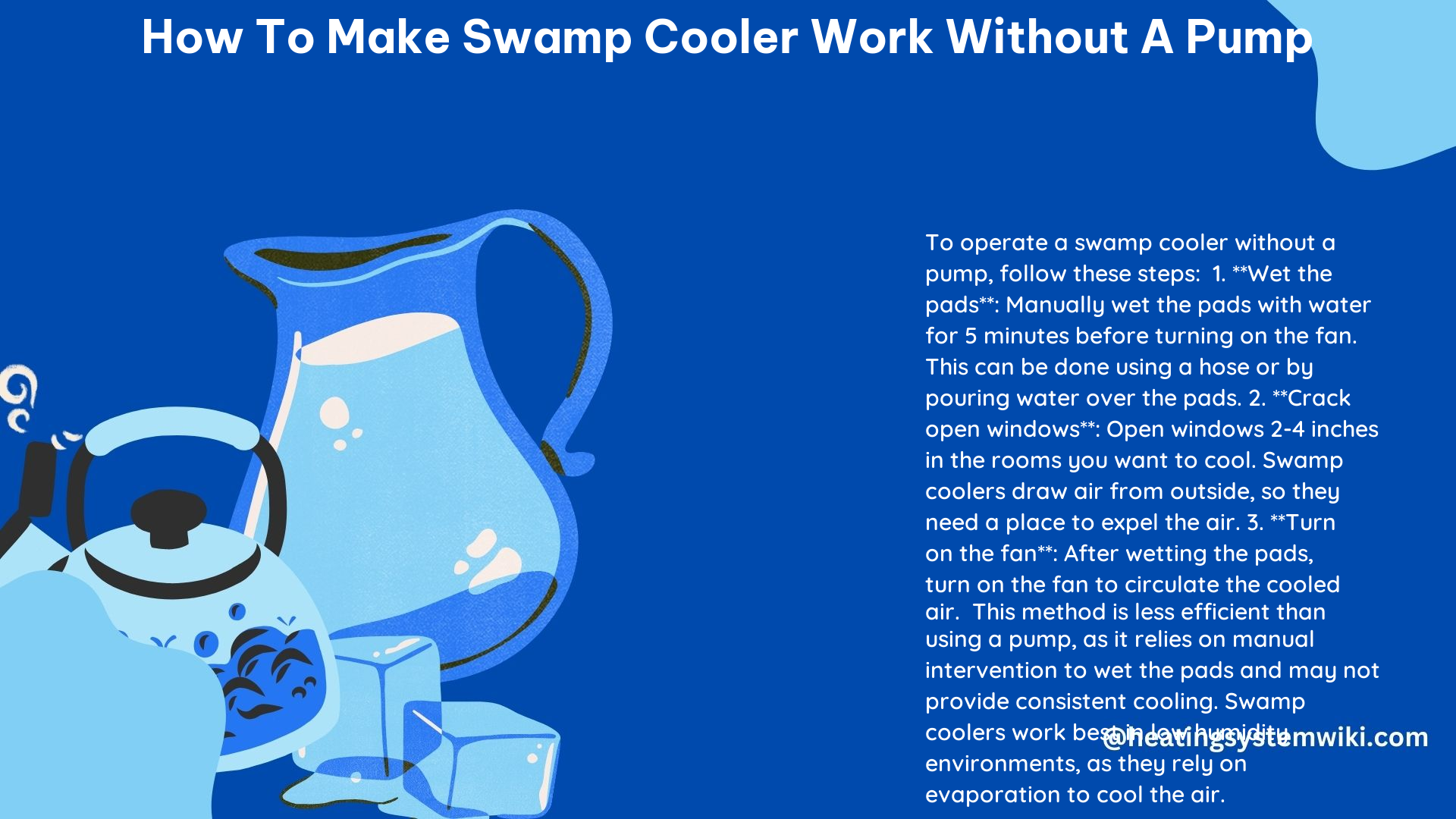Creating a swamp cooler without a pump is a cost-effective and energy-efficient way to stay cool during the hot summer months. By utilizing gravity-fed water distribution, you can enjoy the benefits of evaporative cooling without the need for an electric pump. This comprehensive guide will walk you through the step-by-step process of building a swamp cooler that works without a pump, providing you with the technical details and expert insights to ensure a successful DIY project.
Choosing the Right Water Reservoir
The foundation of your pump-less swamp cooler is the water reservoir. This container will hold the water that will be gravity-fed to the cooling pads. When selecting the right reservoir, consider the following factors:
-
Capacity: The size of the reservoir should be large enough to provide a continuous supply of water to the cooling pads. As a general rule, you’ll want a reservoir that can hold at least 5 gallons of water for a small to medium-sized swamp cooler.
-
Material: The reservoir can be made from a variety of materials, including plastic, metal, or even a repurposed container like a large bucket or barrel. The material should be durable, rust-resistant, and able to withstand the weight of the water.
-
Placement: The reservoir must be positioned at a higher level than the cooling pads to allow gravity to distribute the water. Typically, the reservoir should be placed at least 2 feet above the top of the cooling pads for optimal water flow.
Installing the Cooling Pads

The cooling pads are the heart of the swamp cooler, responsible for the evaporative cooling process. When selecting and installing the cooling pads, consider the following:
-
Pad Material: The most common materials used for swamp cooler pads are cellulose, aspen wood, or synthetic materials like polyester or polypropylene. Cellulose pads are the most efficient, but they may require more maintenance.
-
Pad Dimensions: The size of the cooling pads will depend on the size of your swamp cooler. As a general guideline, the pads should cover the entire front opening of the cooler, with a depth of 4 to 6 inches.
-
Pad Alignment: Ensure that the cooling pads are properly aligned and spaced to allow for even water distribution. The pads should be securely installed in a frame or box that is positioned below the water reservoir.
Designing the Water Distribution System
The water distribution system is responsible for delivering the water from the reservoir to the cooling pads. This can be achieved using a simple PVC pipe setup:
-
Pipe Size: Use a 1/2-inch or 3/4-inch PVC pipe for the water distribution system. This size will provide sufficient water flow without wasting too much water.
-
Pipe Placement: Position the PVC pipe so that it runs along the top of the cooling pads, with small holes drilled at regular intervals (approximately 6 inches apart) to allow the water to drip down onto the pads.
-
Pipe Connections: Securely connect the PVC pipe to the water reservoir using appropriate fittings and adapters. Make sure there are no leaks in the system.
-
Water Flow Adjustment: You may need to adjust the size or spacing of the holes in the PVC pipe to ensure an even water distribution across the cooling pads.
Installing the Fan
The fan is responsible for drawing air through the wet cooling pads and blowing the cooled air into the desired space. When selecting and installing the fan, consider the following:
-
Fan Size: The size of the fan should be appropriate for the size of your swamp cooler. As a general guideline, you’ll want a fan with a CFM (cubic feet per minute) rating that is at least 10% higher than the volume of the space you’re trying to cool.
-
Fan Placement: Position the fan in front of the cooling pads, facing the direction you want the cooled air to blow. The fan should be placed close enough to the pads to create a strong airflow, but not so close that it blows the water off the pads.
-
Fan Power: Choose a fan with enough power to create a strong, consistent airflow through the cooling pads. A high-quality, energy-efficient fan will help minimize your energy consumption.
Testing and Troubleshooting
Once you’ve completed the installation, it’s time to test your swamp cooler and make any necessary adjustments:
-
Fill the Reservoir: Fill the water reservoir and check for any leaks in the water distribution system.
-
Turn on the Fan: Turn on the fan and observe the airflow through the cooling pads. Adjust the fan speed or position as needed to achieve the desired airflow.
-
Monitor Water Flow: Observe the water flow onto the cooling pads. Adjust the size or spacing of the holes in the PVC pipe to ensure even water distribution.
-
Troubleshoot Issues: If you encounter any issues, such as uneven water distribution or insufficient cooling, refer to the troubleshooting guides in the reference links below.
By following this comprehensive guide, you’ll be able to create a highly effective swamp cooler that works without the need for a pump. Remember to regularly maintain your system, keep the cooling pads clean, and adjust the water flow and fan settings as needed to ensure optimal performance.
